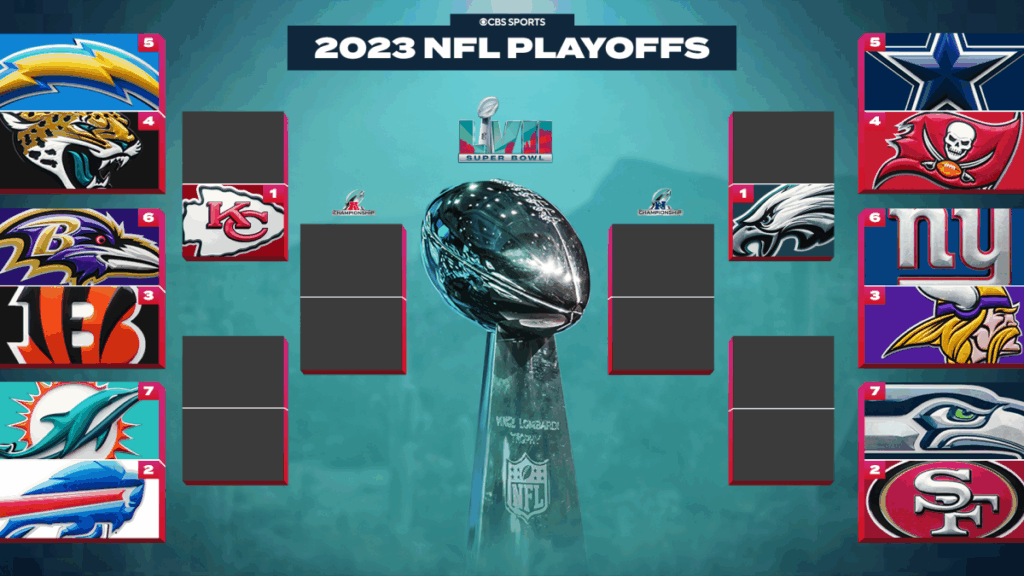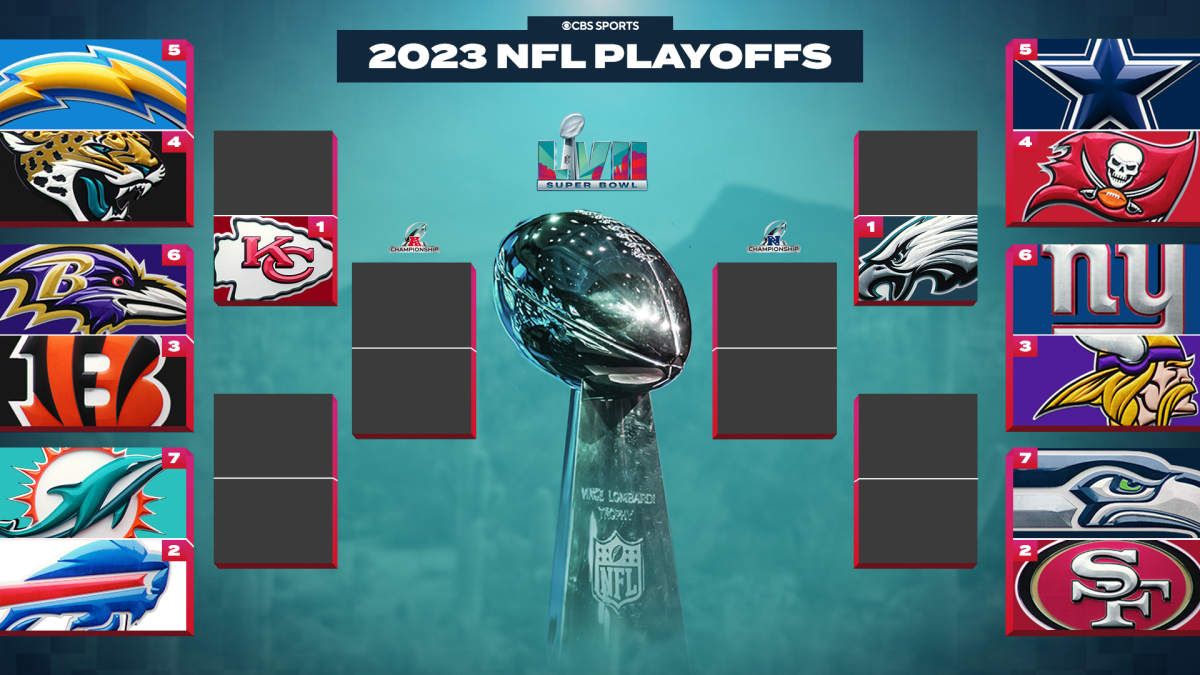
Decoding the NFL Seeding Bracket: A Comprehensive Guide to Playoff Qualification
Understanding the NFL seeding bracket is crucial for any football fan hoping to follow their team’s journey through the playoffs. The intricate system determines which teams make it to the postseason, their opponents, and ultimately, who competes for the Super Bowl. This guide breaks down the process, explaining how teams are seeded, the importance of each position, and the potential scenarios that can unfold as the regular season progresses. Knowing the ins and outs of the NFL seeding bracket will give you a deeper appreciation for the strategic battles on and off the field.
The Basics of NFL Playoff Qualification
The NFL playoffs consist of 14 teams: seven from the American Football Conference (AFC) and seven from the National Football Conference (NFC). These spots are awarded based on regular-season performance, prioritizing division winners and then wild card teams. The NFL seeding bracket dictates the matchups and home-field advantage throughout the playoffs.
Division Winners Take Priority
The four division winners in each conference (AFC North, AFC South, AFC East, AFC West, and NFC North, NFC South, NFC East, NFC West) automatically qualify for the playoffs. They are seeded 1 through 4 based on their regular-season record. The team with the best record in the conference gets the coveted number 1 seed. The remaining three division winners are then seeded 2 through 4 based on their records.
Wild Card Teams Earn Their Spots
After the division winners are determined, the three teams with the best records in each conference that did not win their division receive wild card berths. These teams are seeded 5, 6, and 7, again based on their regular-season records. It’s important to remember that head-to-head records and other tie-breaking procedures come into play when teams have identical records. The NFL seeding bracket relies heavily on these tie-breakers, which can dramatically alter a team’s playoff path.
Understanding the NFL Seeding Bracket
The NFL seeding bracket is structured to reward regular-season success. The higher the seed, the more advantageous the playoff path. Let’s break down the significance of each seed:
The Coveted Number 1 Seed
The team with the number 1 seed in each conference receives a bye week during the first round of the playoffs, known as the Wild Card Round. This provides a significant advantage, allowing the team to rest and recover while also giving them home-field advantage throughout the conference playoffs. Securing the top spot in the NFL seeding bracket is a major goal for any contender.
Seeds 2 Through 4: Division Winner Advantages
The teams seeded 2, 3, and 4, all division winners, host Wild Card Round games. The 2 seed plays the 7 seed, the 3 seed plays the 6 seed, and the 4 seed plays the 5 seed. Home-field advantage can be a crucial factor in these games, as teams often perform better in front of their home crowds. The NFL seeding bracket prioritizes division winners with these home game opportunities.
Seeds 5 Through 7: The Wild Card Grind
The teams seeded 5, 6, and 7 are the wild card teams. They must travel to face division winners in the Wild Card Round. These teams face a tougher road to the Super Bowl, as they must win at least three games, all on the road, to reach the championship game. Despite the challenges, wild card teams have proven capable of making deep playoff runs; understanding the NFL seeding bracket, however, underscores the importance of avoiding a wild card spot if possible.
Tie-Breaking Procedures in the NFL Seeding Bracket
When teams have identical records, the NFL employs a series of tie-breaking procedures to determine playoff qualification and seeding. These procedures can be complex, but they are crucial for accurately determining the NFL seeding bracket. Here are some key tie-breaking rules:
- Head-to-Head Record: If two teams have the same record, the winner of their head-to-head matchup (if applicable) gets the higher seed.
- Division Record: If teams are in the same division, the team with the better record against other teams in their division gets the higher seed.
- Common Games Record: If teams have played the same opponents, the team with the better record against those common opponents gets the higher seed.
- Conference Record: The team with the better record against other teams in their conference gets the higher seed.
- Strength of Victory: The combined record of all the teams a team has defeated.
- Strength of Schedule: The combined record of all the teams a team has played.
If these tie-breakers fail to produce a clear winner, further tie-breaking methods are used, eventually potentially leading to a coin toss (though this is rare). The intricacies of these tie-breaking procedures highlight the importance of every game and every win during the regular season. Understanding these rules is key to predicting the final NFL seeding bracket.
Strategic Implications of the NFL Seeding Bracket
The NFL seeding bracket has significant strategic implications for teams. Coaches and general managers constantly evaluate their team’s position in the standings and make decisions with an eye toward improving their seeding. Here are some key strategic considerations:
Balancing Rest and Momentum
Teams vying for the number 1 seed must balance the desire for a bye week with the need to maintain momentum heading into the playoffs. Resting key players late in the season can help prevent injuries, but it can also lead to a loss of rhythm. Coaches must carefully weigh these factors when making personnel decisions. The NFL seeding bracket incentivizes regular season dominance, but maintaining player health is paramount.
Targeting Specific Matchups
Teams may strategically try to improve their seeding to avoid certain opponents in the playoffs. For example, a team might prefer to play a weaker division winner rather than a strong wild card team. Understanding the strengths and weaknesses of potential opponents is crucial for making informed strategic decisions. The final NFL seeding bracket can significantly impact a team’s chances of advancing.
Home-Field Advantage
Home-field advantage can be a significant factor in the playoffs. Teams often perform better in front of their home crowds, and the noise and energy of the stadium can disrupt the visiting team’s offense. Teams prioritize securing home games throughout the playoffs. The NFL seeding bracket directly impacts which teams get to play in front of their fans.
Predicting the NFL Seeding Bracket
Predicting the NFL seeding bracket is a popular pastime for football fans. Numerous websites and analysts offer predictions based on various factors, including team performance, strength of schedule, and injury reports. While it’s impossible to predict the future with certainty, understanding the rules and tie-breaking procedures can help you make more informed predictions.
Factors to Consider
- Team Performance: Obviously, a team’s win-loss record is the primary factor in determining their seeding. Pay attention to how teams are performing both at home and on the road.
- Strength of Schedule: A team’s schedule can significantly impact their chances of winning games. A team with a difficult schedule may have a lower record than a team with an easier schedule, even if they are equally talented.
- Injuries: Injuries to key players can derail a team’s season. Keep an eye on injury reports and adjust your predictions accordingly.
- Tie-Breaking Scenarios: As the season progresses, pay attention to potential tie-breaking scenarios. Understanding the tie-breaking rules can give you an edge in predicting the final NFL seeding bracket.
Utilizing Prediction Tools
Several websites offer tools and simulations that can help you predict the NFL seeding bracket. These tools typically use statistical models to project the outcome of each game based on various factors. While these tools are not always accurate, they can provide valuable insights and help you identify potential playoff scenarios.
Historical Trends in the NFL Seeding Bracket
Analyzing historical trends in the NFL seeding bracket can provide valuable insights into the dynamics of the playoffs. For example, historically, the number 1 seed has had a higher probability of reaching the Super Bowl than lower seeds. However, there have also been numerous instances of wild card teams making deep playoff runs and even winning the Super Bowl. These historical trends highlight the importance of both regular-season success and playoff performance.
The Importance of Regular-Season Dominance
While anything can happen in the playoffs, regular-season dominance is still a significant predictor of success. Teams that consistently perform well throughout the regular season are more likely to secure a high seed and enjoy a more favorable playoff path. The NFL seeding bracket rewards consistency and excellence.
Wild Card Upsets
Despite the advantages of a high seed, wild card teams have proven capable of pulling off upsets and making deep playoff runs. These upsets often occur when a wild card team is particularly strong or when a high-seeded team is dealing with injuries or other challenges. While the NFL seeding bracket favors higher seeds, it’s important to remember that anything can happen in a single-elimination tournament.
In conclusion, understanding the NFL seeding bracket is essential for any serious football fan. From the importance of division titles and wild card berths to the strategic implications of each seed, the NFL seeding bracket shapes the entire playoff landscape. By following the rules, tie-breaking procedures, and historical trends, you can gain a deeper appreciation for the strategic battles on and off the field and make more informed predictions about the final playoff picture. [See also: NFL Playoff Tiebreakers Explained] [See also: Super Bowl Odds and Predictions] [See also: NFL Mock Draft Analysis]
